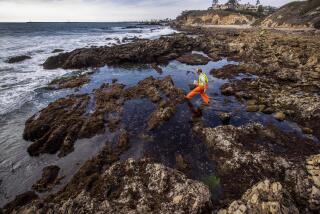Currents may hold secret to gulf oil spill mystery
New research suggests that oil and gas belching from BP’s blown-out well during the Deepwater Horizon disaster disappeared more quickly than expected because of the northern Gulf of Mexico’s geography.
The deep-sea blowout, which produced the largest offshore spill in the nation’s history, occurred off the coast of Louisiana in a portion of the gulf that is almost enclosed on three sides. That influenced water movement in a way that boosted bacterial consumption of the leaking oil and methane gas, according to a study that will be published this week in the Proceedings of the National Academy of Sciences.
“When the hydrocarbons were released from the well, bacteria bloomed,” said the paper’s lead author, UC Santa Barbara geochemist David Valentine. “In other locations, those blooms would be swept away by prevailing ocean currents, but in the Gulf of Mexico, they swirled around at great depths like a washing machine, and often circled back over the leaking well, sometimes two or three times.”
That meant more munching by oil-loving microbes near the wellhead.
Valentine said the research, based on ocean data from the U.S. Navy and computer modeling, could be a template for studies during future deep-sea drilling projects. “If we’re going to be drilling in deep water, we can expect these sorts of deep water plumes if we have a blowout,” he said. “If we want to understand what their impacts are and what their effects might be, we need to know something about the physics of water motion at the locations where we’re drilling and we need to know something about the potential response of the microbes to the input of oil.”
ALSO:
California wolf is named ‘Journey,’ photo released
Sea Shepherd activist arrested filming cove dolphins
USC researchers discover new, cheaper CO2 capture
--Bettina Boxall







